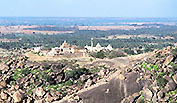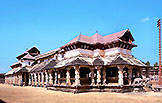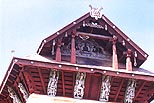|
JAINA ARCHITECTURE
|
TAKEO KAMIYA
|
JAINA ARCHITECTURE
|
Although the founder of Jainism was Mahavira, there had been twenty-three "Tirthankaras" (Jinas) prior to him, just like "Past Buddhas" in Buddhism. Mahavira was said to be the 24th, the last Thirthankara. While the Thirthankaras from the first Adinatha to the 22nd are completely legendary figures, Parshvanatha, the 23rd, is confirmed to have been a historical person. Since it is considered that the life of Parshvanatha had predated Mahavira by about 250 years, the history of Jainism would be much longer than Buddhism. The reason why Mahavira is regarded as the founder is that he reorganized the doctrine of Parshvanatha and completed it as a religion. As his parents who belonged to the royal family were said to have worshipped Parshvanatha, there might have existed a religion to be called "Parshvanism." At the age of thirty, Mahavira renounced the world and abandoned all of his wealth, and gave away all the clothes he wore to the poor, and then started a life as a mendicant with naked body. It remind us of St. Francis of Assisi, the founder of a mendicant order in medieval Italy, who gave up all his property and started ascetic practices without any clothes. (In "Brother Sun, Sister Moon," a movie which portrayed his life, the lower part of his body in that scene was shaded off in Japan). After the death of St. Francis, a gorgeous Basilica of the monastery was constructed in Assisi, which was contrary to his thought of honorable poverty. Enthusiasm for building temples in Jainism could be similar to this situation and sentiment.

Several hundreds years after the death of Mahavira, it is said that there had been a serious drought for twelve years in the Bihar region in Northeast India, where Mahavira had been born. Jainas whose lives were in danger took refuge in a region today known as Karnataka State in South India, with the guidance of the sage Bhadrabahu. Chandragupta, the founder of the Maurya Dynasty followed him since he was a pious Jaina who revered Bhadrabahu as a guru (preceptor). Tradition says that he passed away by observing a fast at Shravanabelagola. These are mere legends and their authenticity is unclear. However, it seems certain that Jainism had reached South India around the beginning of the Christian era. It is believed that by this time Jainism had split into two sects, "Digambra" (Sky-clad) and "Shvetambara" (White-clad). Tradition tells that when Bhadrabahu returned to Northern India, Jainas who had remained there were accustomed to wearing white clothes, which he thought a sign of religious corruption. He parted company with them and established a rigorous sect of Digambra that ordains nudidity in Southern India. If the behavior of St. Francis was "De Imitatione Christi," the case of Bhadrabahu could be described as "De Imitatione Mahaviri." However, it might have reflected the difference of climate between north and south. Winter in North India is rather cold to spend without any clothes. In terms of doctrine, there is scarcely any distinction between Digambara and Shvetambara.
 
�@ The center of Jainism in South India was Shravanabelagola, which is located to the west of Bangalore. This is a surrealistic place where two strange craggy mountains of Chandragiri and Vindhyagiri are facing each other on both sides of the town and a extensive square-shaped water tank. At the peak of Vindhyagiri, there is a 17meter high statue of Gommateshwara that is carved on a rock situated there (*1). Gommateshwara is also known as Bahubali, a son of the first Tirthankara, Adinatha in tradition. The statue, which was carved about 1,000 years ago, depicts his legend: he had practiced asceticism in an upright stance until ivy covered his legs and anthills formed at his feet. There is a group of temples around this statue, but Chandragiri Hill is much more important in terms of architecture. Extremely graceful Mana-Stambha is standing there symbolically and 12 temples accompany it. Although the largest is Kattale Basti (temple) (*2), the one that conveys the characteristics of "Southern Style" most distinctly is the Chamundaraya Basti (temple).
 In the case of the temples in Khajuraho that represent "Northern Style," which we have observed in the previous chapter, the upper structures of sanctum called "shikhara" placed emphasis on the vertical line that stretches upward. On the contrary, it is the horizontal line that is stressed in this temple. Since the edifice consists of tiered layers with complex molding and ornaments, the whole appearance seems rather stocky. It might have reflected the fact that the term "shikhara" in Southern India refers not to the entire upper structure of sanctum, but it only indicates its dome like crowning part of the roof. These sorts of Southern Style stone temples developed mainly in a state now known as Tamil Nadu. (There is a theory claimed by a linguist Susumu Ohno that the Japanese language might have its root in Tamil, a native language of this region.) Meanwhile, from a racial point of view, people of Tamil Nadu are of Dravidian descent, who are totally different from people of Aryan descent in Northern India. These Southern Style of temples therefore are also called "Dravidian Style." (*3) As time passed by, while "Vimana" (main shrine) remained small, surrounding "Gopuras" (temple gateways) became much larger ; the Southern Style temples have given peculiar appearance to towns in South India. However, this aspect was seen mostly in Hindu temples, and Jaina temples were hardly involved in this change.

�@ A holy place of Jainism that takes rank with Shravanabelagola in South India is Mudabidri, which is close to the west coast of the Indian peninsula. This small town holds some eighteen Jaina temples. There is a street that has temples on both sides in a row like a quarter called "temples town" in Japan. A stambha is erected in front of each temple. It is surprising that the temple style in the west coast is completely different from that of Tamil Nadu in spite of being in the same Southern part of India. As is typically seen in Chandranatha Basti, the largest temple in Mudabidri, although the under part of this temple is made by stone masonry, its upper part is made of wood, and has a pitched gable roof atop. Despite the fact that this town belongs to Karnataka State, this "West coast Style" is rather linked to Kerala State, which is located south of this town. Since there are the Western Gats Mountains between the states of Kerala and Tamil Nadu, this narrow coastal land enjoys a lot of precipitation and lush pasture throughout the year. Thus it has nurtured a culture which is totally different from the dry region of Tamil Nadu. That climate resulted in a wooden gable roof which is called "West coast Style." Even though most temples in Kerala State belong to Hindus and show a little difference to Jaina temples in Karnataka, both of them share characteristics in their gable ornaments and carved struts that support eaves. It strikes me as strange that these temples are so much alike to those in Nepal, which is far away from here.

James Fergusson, who had systematized the history of Indian architecture for the first time, speculated that there had been a certain influential relationship between wooden temples in South India and those in Nepal. In time, however, a study conducted by R.M. Bernier etc. revealed that the climatic conditions and land produced similar architectural styles and there had not been any obvious correlation between one another. It is clearly endorsed by the fact that roofs of the Nepali temples are basically pyramidal or hipped roofs, and there is hardly any temple that has an ornamentally gabled roof. There is another mysterious group of buildings in Mudabidri. They look like multiple tiered towers in Nepal, but they are made not of wood but of laterite (*4). These buildings are said to be graves of Jaina saints. Since most Indian religion, be it Hinduism or Jainism, basically holds a concept of "Samsara" (transmigration), which means that every living being will reincarnate without fail, there had not been any custom of making a grave. It is therefore an incomprehensible mystery that only Jainas in this area had built graves, and furthermore, their forms are similar to the towers in Nepal or "Meru" in Bali. (*5)
 Laterite tombs of Jaina Priests, Mudabidri The "Digambara" (Sky-clad) sect in Southern India is also called the rigorous sect, and it insisted on observing the teachings of Mahavira more faithfully. However, against its public declaration, monks were said to have led more secular lives. The reason for this situation in South India was that they had developed a custom of founding monasteries around Jaina temples and had settled down there. It had been primarily supposed in Jainism that monks who renounced the world were able to stay at one place during four months of the rainy season in a year, but at the time of the dry season, they were to go about asking for alms from towns to villages, and in the forest as well. It was because they believed that if monks settled down at one place, they would certainly be secularized, build up fortunes, become materialistic, and thus come to be separated from the principle of "non-possession, non-attachment." This situation is clearly seen in Japanese Buddhism. Monks who originally ought to have "renounced the world" settle themselves in houses, form families, build up property and make their profession a family business. A Jaina monk whom I met at "matha" (monastery) in Mudabidri wore orange clothes and seemed to me secularized, even though he was not married. It was at Deogarh in North India where I met a true Digambara monk. On that day, so many Jainas living in the neighborhood of Deogarh crowded at an old temple, since a monk of high virtue (guru) was to visit there with his disciples to deliver a religious discourse. The guru, who had already discarded worldly attachment, wore nothing except having a brush made of peacock feathers. (*6) He was literally a Sky-clad, like Bhadrabahu and St. Francis of Assisi in old times.
 
It was the first time that I learned the fact that covering one's mouth with a white mask is a custom peculiar to Shvetambara, and people of Digambara do not have that custom.
|